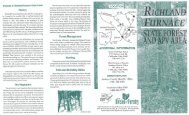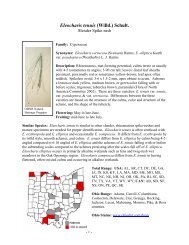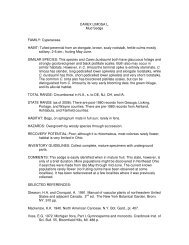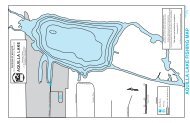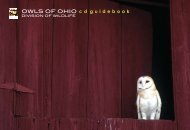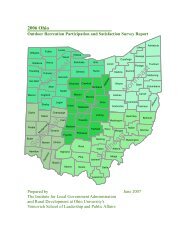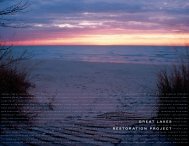Wildlife in Full Color - Ohio Department of Natural Resources
Wildlife in Full Color - Ohio Department of Natural Resources
Wildlife in Full Color - Ohio Department of Natural Resources
Create successful ePaper yourself
Turn your PDF publications into a flip-book with our unique Google optimized e-Paper software.
COLOR SCHEME: COMPLEMENTARYComplementary colors are opposite <strong>of</strong> each other on the color wheel. The high contrast between huescreates a vibrant look, especially when used at full saturation.THE COLOR OF SCIENCEPeople have studied fish for a long time.The more biologists learn about fish, themore they can learn about their habits,their habitats, and their needs for survival.Fish biologists study fish populations andhabitat. Biologists weigh, measure, andage millions <strong>of</strong> fish to study how healthytheir populations are. How do they gettheir hands on large numbers <strong>of</strong> fish? Theanswer may shock you.Biologists use color <strong>of</strong> fish to theiradvantage. You know the commonpattern <strong>of</strong> a fish, the darker side is on thetop and the lighter side is on the bottom<strong>of</strong> a fish. Biologists use a technique called“electro shock<strong>in</strong>g” to temporarily still aswimm<strong>in</strong>g fish. A carefully regulated electriccurrent is sent through the water,and the fish will flip upside-down. Biologistsare ready with nets so when they seethose white bellies, they scoop up the fish,gather <strong>in</strong>formation, and then return therecovered fish to the water.THE COLOR OF THE CATCHTake a stroll through any store thatsells fish<strong>in</strong>g tackle or artificial bait and youwill see a ra<strong>in</strong>bow <strong>of</strong> colors. Anyth<strong>in</strong>gfrom bright red, to “pumpk<strong>in</strong>seed,” tochartreuse, anglers keep a huge selection<strong>of</strong> color <strong>in</strong> their tackle boxes because fishwill sometimes choose one color <strong>of</strong> baitover another. When anglers bait theirhook, they are try<strong>in</strong>g to mimic food thatthe fish might eat. If the bait looks enoughlike food, the fish will bite. There arevarious reasons for decid<strong>in</strong>g which bait touse. Anglers are try<strong>in</strong>g to catch fish bycatch<strong>in</strong>g their eye. If the water is murkyor not clear, anglers will use brightercolored bait so the fish can see it better.If the water is clear and the bait is morevisible to the fish, colors that are morenatural are used.FISH FLOP: the different colors<strong>of</strong> a white bassACTIVITY: A COLORFUL CROSSWORDFill <strong>in</strong> the fish’s name that conta<strong>in</strong>s a color or pattern. See answers on back cover312ACROSS 3. ____ catfish4. ____ darter5. ____ worm6. ____ sunfish7. ____ crappie8. ____ perch9. ____ bass456789DOWN 1. southern ____ dace2. ____ trout4. ____ sunfish6. ____ redhorse2011 - 2012 WILD OHIO MAGAZINE15



